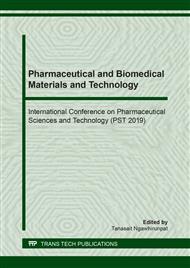p.195
p.202
p.209
p.215
p.221
p.227
p.233
p.240
p.246
Matrix Forming Behavior of Doxycycline Hyclate-Loaded Beta-Cyclodextrin In Situ Forming Matrix and Microparticle
Abstract:
In situ forming microparticle (ISM) is an injectable emulsion drug delivery system comprising drug loaded in polymeric solution as internal phase and oil combined with emulsifier as external phase. This emulsion transforms into microparticle after contact an aqueous environment by solvent exchange mechanism. This study developed ISM using internal phase comprising 5% w/w doxycycline hyclate (DH) loaded with various concentrations of beta-cyclodextrin (β-CD) using N-methyl-2-pyrrolidone (NMP) as a solvent and external phase containing olive oil combined with glyceryl monostearate (GMS). High concentrated β-CD solutions in NMP are used as the internal phase of ISM. Matrix forming behavior is evaluated for their particle size, transformation to microparticle, pH, rate of matrix formation, contact angle and surface tension. Each emulsion had similar pH values about 3.5-4.1 and transformed into microparticles (particle size about 60 μm) after contact with phosphate buffer pH 6.8. The particle sizes of each preparation decreased significantly after transformed into microparticles and the more microparticles were evident with time. The rate of matrix formation of ISM was apparent slower than its internal phase and was slower with time. Contact angle of ISM and its internal phase showed good wetting which the surface tension of 35% w/w β-CD ISM was 44.19 mN/m. The β-CD ISM exhibited as the potential delivery system for incorporation of active compounds.
Info:
Periodical:
Pages:
221-226
Citation:
Online since:
August 2019
Price:
Сopyright:
© 2019 Trans Tech Publications Ltd. All Rights Reserved
Share:
Citation:


